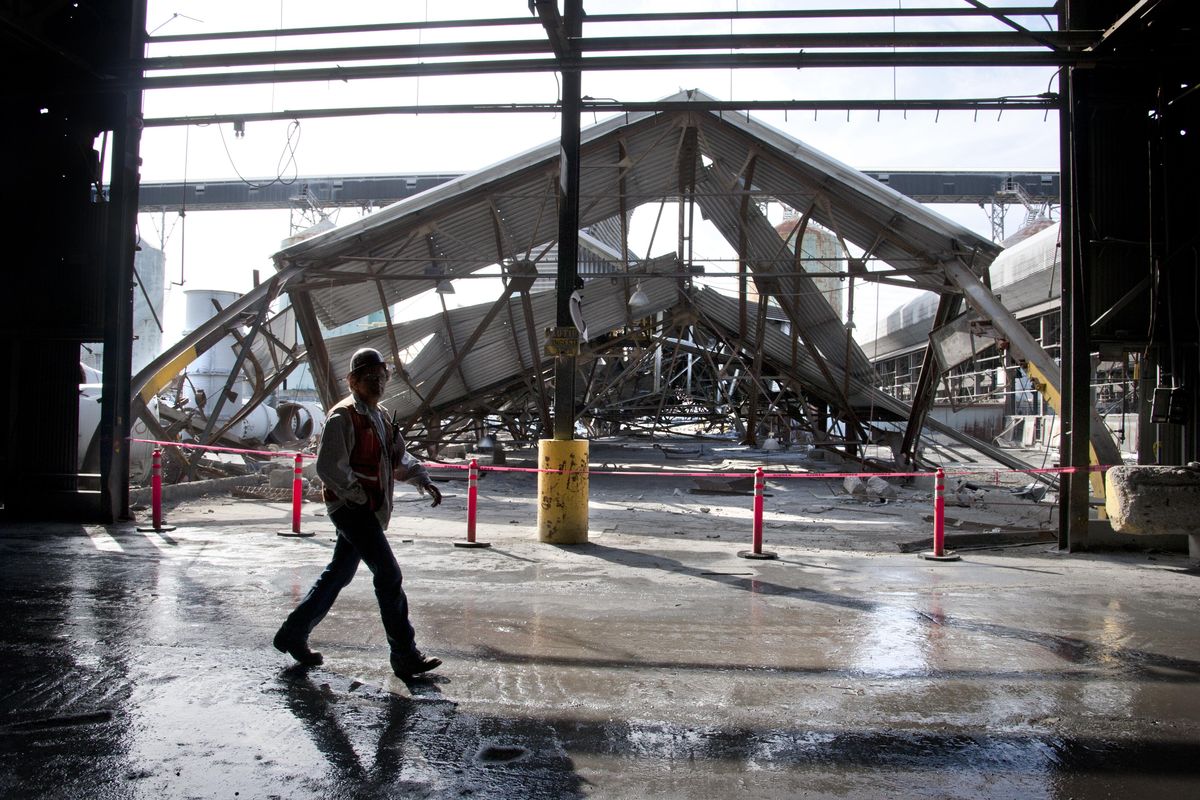New cyanide cleanup plan proposed for former Kaiser Aluminum smelter site in Mead

State environmental regulators and a public trust formed through Kaiser Aluminum’s bankruptcy have developed a new multimillion-dollar plan to clean up cyanide pollution discovered four decades ago from an old smelter in Mead.
A plume of the potentially deadly chemical was first discovered in August 1978 in private wells near the former smelter on Hawthorne Road. A couple dozen homes in the area were hooked up to public water systems at Kaiser’s expense, and the company covered 128,000 tons of potentially toxic material with an asphalt cap intended to keep the chemical produced in the smelting process from leaching into the groundwater following rainfall and snowmelt.
“It was hoped that could be enough, that the groundwater would naturally cleanse itself,” said Garin Schrieve, the site’s manager for the Washington Department of Ecology.
But recent testing, coinciding with wholesale giant Costco’s interest in relocating a north Spokane warehouse in the area, showed levels far exceeding environmental standards. Results from test wells in the area in 2017 showed groundwater cyanide concentrations that were eight or nine times greater than allowable limits under a cleanup agreement signed in 2002.
None of the homes in the area, or the recently constructed Costco, are drawing well water following discovery of the contamination in the 1970s. Instead, they receive water from the nearby Whitworth Water District public system.
“This stuff does eventually make it to the Little Spokane River,” Schrieve said. “But we see in the springs, that the concentrations of this stuff is pretty low. That said, we don’t like to have contaminants in our potential drinking water.”
The Washington Department of Ecology is now recommending a new pump and treatment system be built on the site, with treated groundwater flowing into a natural wetland system that is intended to reduce contaminants. When exposed to sunlight, cyanide begins to break down.
“The option we selected is a good balance of costs and benefits,” Schrieve said.
Treated water would then flow through an underground pipe to an infiltration pond, according to the plans, where it would filter back into the soil.
A preliminary report from the Ecology Department indicates such a system would cost close to $4 million, with an annual operations cost of $1 million. A public trust, formed when Kaiser Aluminum went bankrupt in 2002 some two years after the smelter in Mead was shut down due to energy costs, will be responsible for hiring a contractor to build the system.
Daniel Silver, a former Ecology Department employee who’s now serving as head of the trust overseeing the cleanup, said the goal is to have a design-and-build team under contract by May, with the system online and operational in 2020.
When Kaiser Aluminum declared bankruptcy in 2002, part of its settlement agreement was to purchase an insurance policy to cover potential environmental cleanup costs. That fund, which has between $13 million and $14 million available, will be tapped to pay for construction and operation of the new facility, Silver said.
Silver said the system has already been tested on a small scale for effectiveness in treating continuation of cyanide and fluoride, another chemical that’s been discovered in the groundwater as a result of the smelting process.
“Alcoa aluminum is the one who came up with this technology,” Silver said. “They have used it at several of their plants, including in New York state. It works in the winter as well as the warmer months.”
The system would produce about 1,000 tons of sludge per year, which would either be trucked to a landfill or a hazardous waste facility, based on an analysis results of its toxicity by Ecology officials.
The public will be allowed to offer comment on the plan through April 26, and can request a public hearing with members of the trust and environmental officials. Schrieve said the department has already contacted property owners in the area about their plans to drill new wells and build the treatment facilities, as well as the region’s native tribes and other stakeholders.
Kathy Spencer, a homeowner in the Camelot neighborhood northwest of the old smelter near the new Costco, said she’d received notification about the plans via email. Spencer said Thursday she applauded the cleanup efforts, but wondered what effect they would have on plans to develop the sprawling, forested 400-plus acres Kaiser Aluminum still owns near the plant that have become more attractive following the opening of the Costco last summer.
“They can’t do anything until the property is cleaned up. That’s my curiosity, is who are these people really been driven by?” said Spencer, who’s owned a home in the area since 1984. “I don’t have any problem, neither would the neighborhood in terms of the development of that property. But it’s going to impact us in terms of traffic.”
The area surrounding the Costco site is zoned for mixed-use development, which could include residential homes, apartment buildings and most types of businesses. Kaiser Aluminum was granted a zoning change to permit such uses on the property in 2010 by Spokane County commissioners.
If officials move forward with the proposed cleanup plan, wells on the site will be monitored to determine the system’s success, Schrieve said. But it’s unclear how long they’d have to operate to reduce cyanide levels to the threshold established by environmental regulators.
“This site, whether the pump and treat system is approved, is going to be monitored forever,” he said. “The pump and treat system, it’s going to be run for years. Whether it’s five years, 10 years, 30 years, we’re going to have to see.”
